Ambarsare de papad ve mei khandi na
Tu karenda akad ve mei sehndi na….
A popular Punjabi song is sung by Dolly Guleria, a Punjabi singer, and features today’s destination “Amritsar”.
Founded in the 16th century by the fourth Sikh Guru, Guru Ram Das, Amritsar today boasts a beautiful blend of tradition, culture, history, food, and shopping. It is the largest urban area in Punjab and the most significant religious center for Sikhs, which makes it one of the best places to visit in Punjab.
Did you know? Many lore and legends weave a mythical link between Amritsar and the Hindu epic Ramayana. It is said that Amritsar is the location of Maharishi Valmiki’s ashram where Devi Sita gave birth to her twins, Luv and Kush.
The next line is going to blow your mind! The symbol of heroism and the holiest shrine of the Sikhs, the Golden Temple in Amritsar receives over 1 lakh visitors daily!!! Can you imagine this many people at one religious shrine? It’s crazy!
Amritsar is a city that is to be experienced more than to be seen. So, if you want to experience the magic of Amritsar and explore its bustling bazaars, colorful festivals, delicious food, historic edifices, and religious structures, we give you the very best places to visit in Amritsar that should be on your to-do list.
List of 10 best places to visit in Amritsar
1. The Golden Temple – Holiest Sikh shrine
2. Wagah Border – Beating Retreat and Change of Guard ceremonies
3. Partition Museum – Post-partition artifacts
4. Jallianwala Bagh – Saga of the freedom struggle
5. Akal Takht – One of the five seats of power in Sikhism
6. Gobindgarh Fort – 7D Show “Sher-e-Punjab”
7. Durgiana Temple – Half Gold, Half Marble
8. Mandir Mata Lal Devi – Largest Cave temple in Amritsar
9. Gurudwara Bir Baba Budha Sahib – Dedicated to Baba Budha Ji
10. Maharaja Ranjit Singh Museum – Devoted to the Lion of Punjab
1. The Golden Temple
Haven’t been to Golden Temple? You are missing out on travel gold!
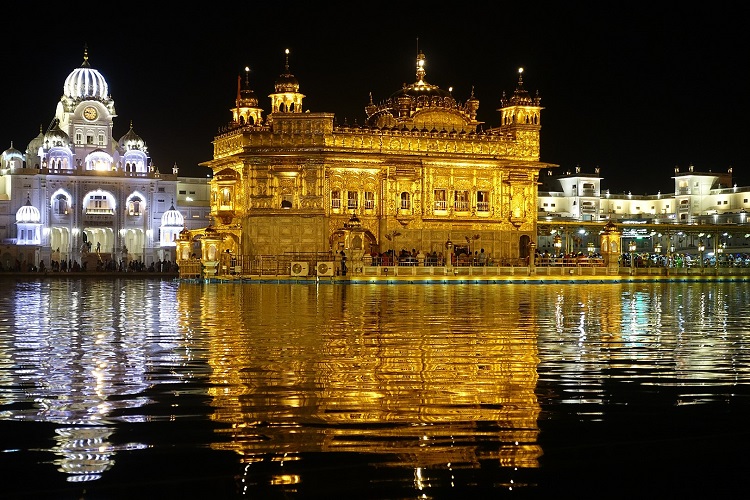
Locally known as Harmandir Sahib, Golden Temple in Amritsar is the star attraction in Punjab. It is a two-story gurudwara (temple) covered in pure gold and is surrounded by a 5.1-meter deep manmade lake what we also call Sarovar. It is one of the most sacred places in the world for Sikhs, many of whom visit here at least once in their lifetime.
Enter into the inner sanctum of the temple, where you’ll see priests or ragis chanting prayers. You will also find the largest community kitchen in the world at Golden Temple serving free vegetarian meals or langar to its visitors. If you wish, you can get involved and volunteer to help in the kitchen and have a bonding time with the locals preparing lunch. Not only this but you also have the option to sleep in pilgrim hostels for up to three nights.
Dos – Remove your shoes and cover your head before entering the Gurudwara.
Don’t – Chew gum, wear sunglasses, or click pictures. Swimming in the Sarovar is strictly prohibited.
Where is Golden Temple located? Golden Temple Road, Atta Mandi, Katra Ahluwalia, Amritsar
Gurudwara Timings – 3 am-10 pm daily
Entry fee – Free entry
Checkout the package for the Golden Triangle Tour with Amritsar
2. Wagah Border
Patriotic enough? If yes, visit the Wagah border. If not, then also visit Wagah Border.

Located around 28 km away to the west of Amritsar lies the famous Wagah Border. It is one of the important places to visit near Amritsar within 50 km. At Wagah Border, a border-closing ceremony can be seen at sunset every afternoon.
Filled with glory, the Beating Retreat Ceremony showcases the guard from the Indian Border Security Force and the Pakistan Rangers, saluting each other, lowering and folding the country’s flags, and closing the gates of the border.
You should visit this place near Amritsar with kids to see the severe difference on both sides. On Pakistan’s side, the men and women sitting separately seem low-spirited, while on India’s side, it feels like a patriotic party. Bollywood music is thriving from speakers and people dance in the streets.
Duration of the ceremony – 45 minutes
Where is Wagah Border located? Wagah Border, National Highway 1 PB, Amritsar
Wagah Border Timings – 10 am-4 pm
Ceremony timings – 4.15 pm-5 pm (winter)
5.15 pm-6 pm (summer)
Entry fee – Free entry
Seating – first come first served basis
Book your Himachal with Amritsar Itinerary
3. Partition Museum
Which was the biggest year for Indians? 1947, duh!
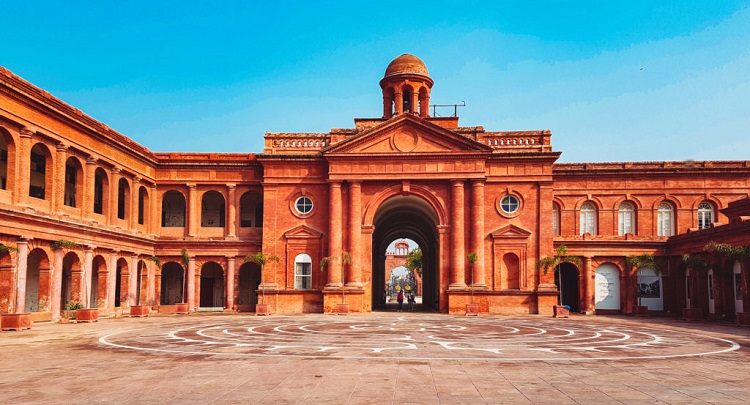
We not only gained our freedom from Britishers after 200 years but also got divided into two countries – India and Pakistan. This happening is also called the Partition of India. So, if you wish to gain an insight into this “defining” moment in history, visit Partition Museum in Amritsar. It is the only institution in the world dedicated entirely to Indo-Pak Partition, which makes it a must-place to visit in Punjab.
An unforgettable collection of newspaper cuttings, old photographs, and oral history of Indians who experienced this traumatic event are featured here. After visiting the museum, you will 100% get a deeper understanding of the source of the dispute between India and Pakistan.
Must-do: On your way out of the Partition Museum, write a note on a green leaf and hang it on the Tree of Hope.
Where is the Partition Museum located? Hall Road, Town Hall, Katra Ahluwalia, Amritsar
Partition Museum Timings – 10 am-6 pm, Tuesday to Sunday (closed on Mondays, 26th January, 15th August, and 2nd October)
Entry fee –
- Indians – INR 10
- Foreigners – INR 250
- Children (5 and below) – Free
- Partitions Survivors – Free
4. Jallianwala Bagh
Ever heard about the Punjab massacre? Well, the uneventful tragedy took place at Jallianwala Bagh in Amritsar.
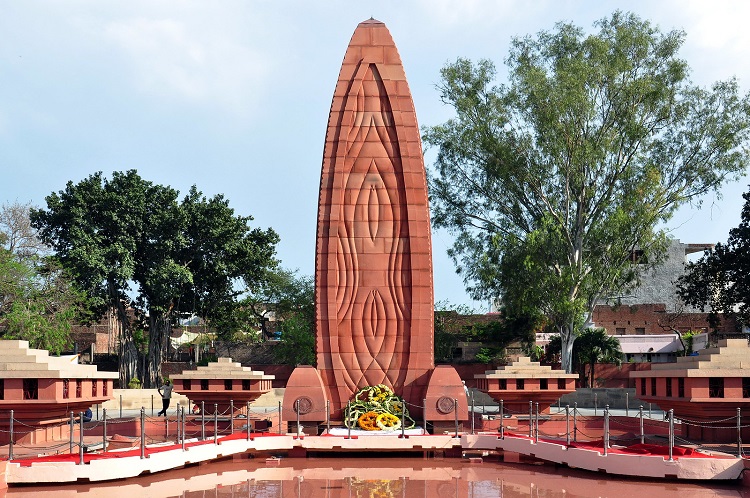
Located behind the religious shrine of the Golden Temple, you will find the Jallianwala Bagh. It is a public garden, which commemorates around 1,500 people who were killed or injured in the Jallianwala Bagh massacre in 1919. You can still see the bullet holes in the walls here, behind which hundreds of victims hid to save themselves from the gunfire. There is a memorial section called Martyr’s Gallery at the site that shows the portraits of significant leaders of Indian independence. Pay a visit and check out a humbling exhibition of the Jallianwala Bagh tragedy and witness an eternal flame.
What was the cause of the Jallianwala Bagh massacre? British soldiers were ordered to fire on the peaceful protestors who were just demanding the release of imprisoned leaders of the 1919 Indian Independence Movement.
Where is the Jallianwala Bagh located? Golden Temple Road, Jallan Wala Bagh, Katra Ahluwalia, Amritsar
Jallianwala Bagh Timings – 6.30 am-7.30 pm daily
Martyr’s Gallery timings – 9 am-5 pm (summers)
10 am-4 pm (winters)
Entry fee – Free entry
5. Akal Takht
You must have heard beauty with brains but ever heard beauty with power?
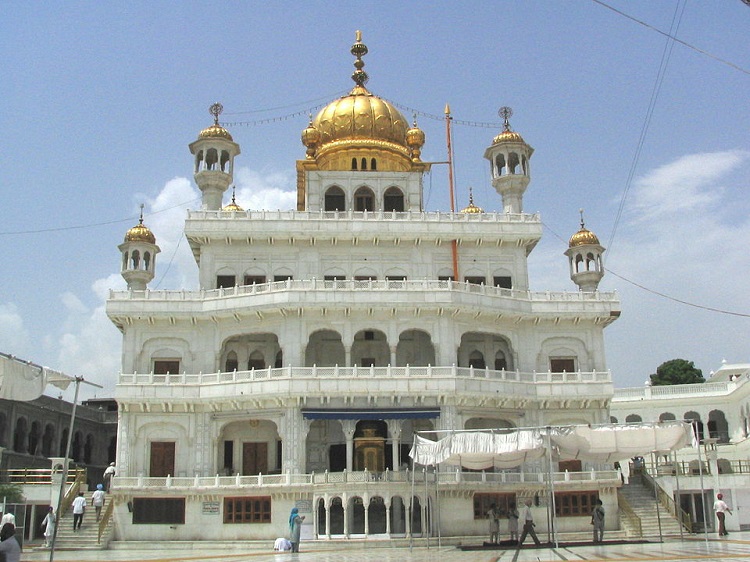
Akal Takht meaning ‘Throne of the Timeless One’ is a Sikh temple that not only has marvelous architecture but also is one of the five seats of power in Sikhism. Interesting, right? Also to your surprise, this Gurudwara is considered to be as important as the Golden Temple by the Sikhs. Guru Hargobind Ji, the sixth Guru of Sikhs, founded Akal Takht in 1606 and since then pilgrims have visited here in large numbers every single day.
A five-storied white structure, features stunning architecture, marble inlay, and a gold-leaf dome. If you seek inner peace, Akal Takht is one of the best places to visit in Amritsar. Moreover, this gurudwara is meant to be a symbol of political sovereignty and justice, where Guru Gobind Singh Ji used to sit and handle the spiritual and practical concerns of the Sikh people.
If Akal Takht is one of the ‘takhts’ (seats of power), which are the others?
The other Takhts of Sikhism are – Takht Sri Keshgarh Sahib (Anandpur), Takht Sri Patna Sahib (Bihar), Takhat Sri Hazur Sahib (Maharashtra), and Takht Sri Damdama Sahib (New Delhi).
Where is Akal Takht located? Golden Temple Road, Atta Mandi, Katra Ahluwalia, Amritsar
Akal Takht Timings – 2.30 am-10 pm daily
Entry Fee – Free entry
6. Gobindgarh Fort
Want to see the glory of Maharaja Ranjit Singh in one place?
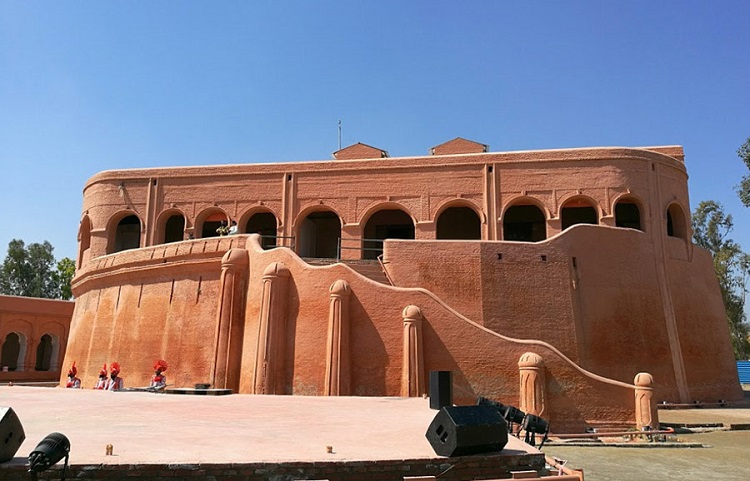
More than 250 years old, the magnificent Gobindgarh Fort is one of the most iconic attractions to visit in Amritsar. This heritage place dates back to the time when the Indian sub-continent was sectioned into small principalities and ruled by kings. Did you know? At one point around 12,000 soldiers guarded Gobindgarh Fort to protect Amritsar from the invaders.
Today, Gobindgarh Fort stands strong and has been converted into an educational attraction. There are several folk performances, activities, and rides. You can also shop for phulkari, handicrafts, and other items at Haat Bazaar. So, if Sikh history and culture interest you, visit Gobindgarh Fort in Amritsar.
What not to miss here?
- A 7-D show called ‘Sher e Punjab’ – showcases the glory of Maharaja Ranjit Singh.
- ‘Kandha Boliyan ne’ meaning whispering walls – a story on Gobindgarh.
- Warfare Museum – having rare instruments and weapons from old times.
- Pagdi Museum or Turban Museum – depicts interesting forms of pagdies of Punjab, Sikhi, and Non-Sikhi.
- Sikh Art Museum – an exhibition about famous warriors and saints of Punjab.
- Toshakhana – where the royal treasury of Maharaja Ranjit Singh lies.
Ambarsari Zaika DHABA serves lip-smacking cuisine and is the perfect place to find out why Amritsar is called the “Food Capital of Punjab”.
Where is Gobindgarh Fort located? Old Cantt Road, inside Lohgarh Chowk, Vijay Chowk, Amritsar
Gobindgarh Fort Timings – 10 am-10 pm
Show and Museum Timings –
- Sher e Punjab – All Day, Show in Punjabi with English subtitles
- Kandha Boliyan ne – Daily 2 shows post-sunset, Show in Punjabi and English
- Pagdi and Sikh Art Museum – 10 am-7.30 pm
- Toshakhana – 10 am-7 pm, Tuesday to Sunday
- War Museum – 10 am-7 pm, Tuesday to Sunday
Entry Fee –
- Sher e Punjab – INR 199 per person valid till 4 pm
- Kandha Boliyan ne – INR 199 per person valid till 4 pm
- Maharaja Ticket – INR 358 per person
- Sawari Ticket – INR 175 per person valid till 4 pm
7. Durgiana Temple
You might have never seen anything like this!
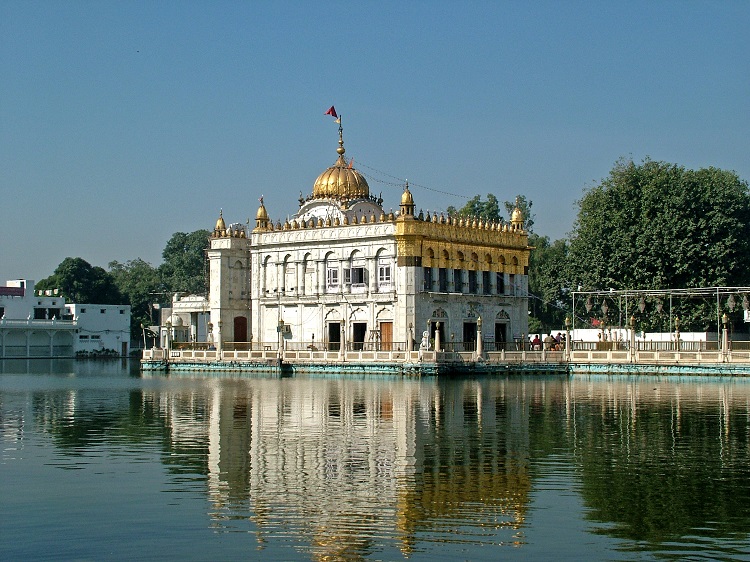
Take one look at Durgiana Temple in Amritsar and you will be mesmerized by its half-gold, half-marble facade. Not joking! This dome’s structure looks similar to the Golden Temple and even has a center sacred lake. Therefore, it is one of the must-visit places in Amritsar. While the Durgiana Temple and Golden Temple both seem similar in looks, but certainly have many different purposes. Golden Temple is a Sikh temple and Durgiana Temple is a Hindu religious site.
Devotees from all across the country come here to pay their respects to warrior goddess Durga, wealth goddess Lakshmi, and the protector of the universe, Vishnu. Most religious travelers can be seen here, but everyday tourists can also visit to look at the marvelous architecture of the temple.
Attention to Detail – On your way inside, pay close attention to the beautiful silver doors, portraying holy figures. This unique feature is where the nickname ‘Silver Temple’ for Durgiana Temple arose.
Where is Durgiana Temple located? Shree Durgiana Tirath, O/S. Hathi Gate, Goal Bagh, Amritsar
Durgiana Temple Timings – 6 am-10 pm daily
Entry fee – Free entry
Related tour package: 8 days Nau devi darshan tour package
8. Mandir Mata Lal Devi
Mandir Mata Lal Devi is the largest cave temple in Amritsar!

Dedicated to Lal Devi, a female saint in the 20th century, Mandir Mata Lal Devi is one of the best places to visit in Amritsar for Hindu devotees. Popularly known as ‘pujya data’, Mata Lal Devi is a mother figure for his followers. And therefore, is known as Mother India Temple. The temple was built in 1989 in Rani Bagh in Amritsar and is believed to have miraculous powers.
Devotees, especially pregnant women visit Mandir Mata Lal Devi to get Devi’s blessings. It is a beautiful place with the main hall containing various Gods and Goddesses, but Mata Lal Devi’s figure is placed at the center. Also, the way to the last hallway is led by the cave, which is lit by lights. You can also see lovely waterways and tunnels here.
Did you know? The Mata Lal Devi Mandir is based on the famous Vaishno Mata Mandir in Jammu and Kashmir.
Where is Mandir Mata Lal Devi located? Shivaji Park Rd, Mohindra Colony, Amritsar
Mandir Timings – 5 am-11 pm
Entry fee – Free entry
9. Gurudwara Ber Baba Budha Sahib
Did you know? Fifth Sikh Guru, Guru Arjan Dev Ji visited Baba Budha Ji in hopes of being blessed with a child!

Also called Ber Sahib, this gurudwara is dedicated to Baba Budha Ji, who lived for 125 years and was also the first granthi. He was blessed by the first Sikh Guru, Guru Nanak Dev as a boy, who further appointed the first five Sikh Gurus. Coming back to the gurudwara, it lies south of Amritsar, near the village of Jhabal Kalan, and is one of the best places to visit in Amritsar within 50 km.
On your way to Gurudwara Ber Baba Budha Sahib, see the rich paddy field and wheat fields of Punjab. It is the perfect way to feel the essence of true rural Punjab. Don’t you agree? Inside the gurudwara, the holy Sikh book Guru Granth Sahib is placed on a white marble canopied by a piece of clean cloth. Many devotees come here to get Baba Budha Ji’s blessings in hopes of a child.
Why visit? To get blessings, of course. But also, the gurudwara prepares the meal in honor of Mata Ganga and serves Missi roti and onion as prasad. Also, near the residential block, there is a two-storied building, where guru ka langar is served. Each Bikrami month followers in masses attend the Gurupurab celebrations, making it the biggest function of the year here.
Where is Gurudwara Ber Baba Budha Sahib located? Clock Tower Building, The Golden Temple Amritsar, Golden Temple Rd, Atta Mandi, Katra Ahluwalia, Amritsar Cantt.
Gurudwara Timings – Open all day
Entry fee – Free entry
10. Maharaja Ranjit Singh Museum
Have a keen interest in knowing more about Sikh history? Visit the museum of ‘Lion of Punjab’, Maharaja Ranjit Singh!
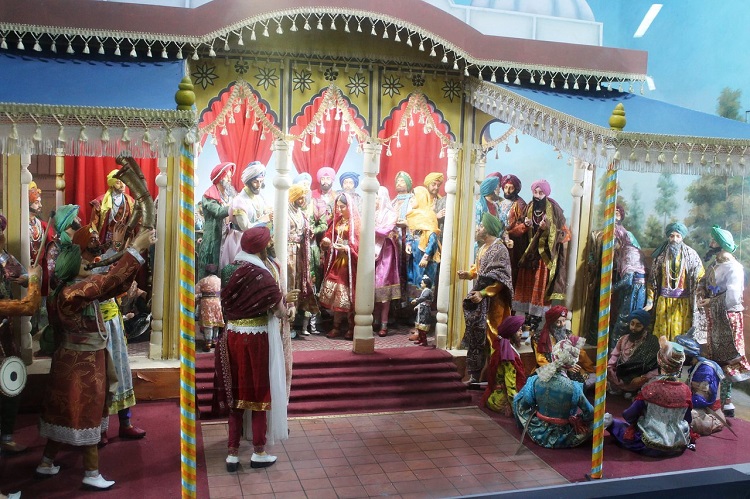
Located in Company Bagh in Amritsar, this museum served as a summer palace of the first king of the Sikh Empire, Maharaja Ranjit Singh. It provides an insight into the king’s life and recounts tales of glory, art, and depicts the beautiful architecture of the Sikh community between the 18th and 19th centuries. Once a summer palace, the museum was converted into a museum in 1977 with a lot of artifacts and personal items of Maharaja like weapons and armor.
Inside the museum, gaze at the fantastic paintings, coins from centuries, and various manuscripts. Most of the paintings depict scenes from the Sikh monarch’s court and camp. Among all of them, the most prominent is the one portraying the Lahore city of Pakistan.
Significant section – See the Rambagh Gardens known for its statue of the legendary king with his horse.
Where is the Maharaja Ranjit Singh Museum located? Town Hall, Katra Ahluwalia, Amritsar
Museum Timings – 10 am-5 pm, Tuesday to Sunday, closed on Mondays
Entry fee –
- INR 40 for adults
- INR 20 for children (5 years and above)
- Free entry for children below 5 years of age
This was our take on the best places to visit in Amritsar. Which place do you want to visit first? Also, do not forget to try out the mouth-watering Amritsari Kulche, which is one of the reasons for Amritsar’s fame. Plan a trip to experience the delectable food, delve into spirituality, and gain insight into Sikh culture and history.

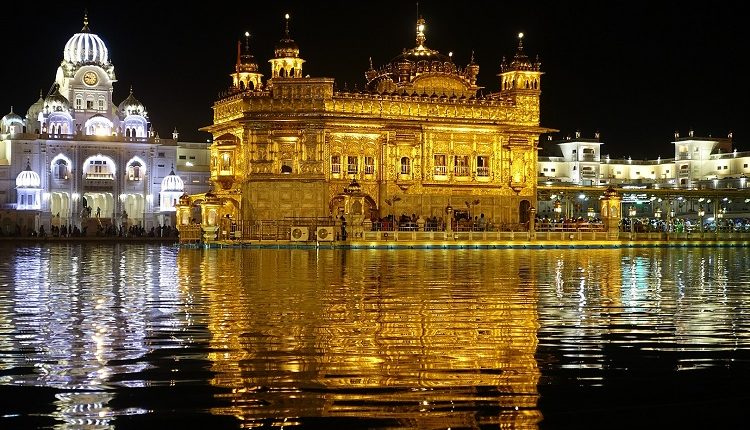



Leave a Comment